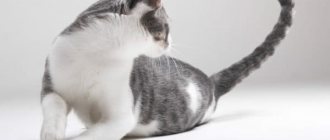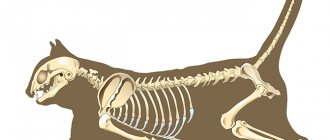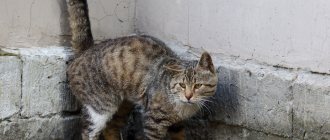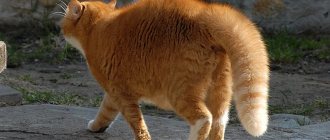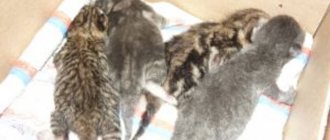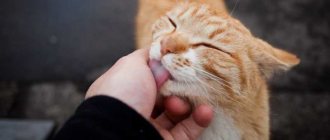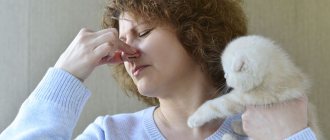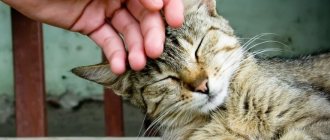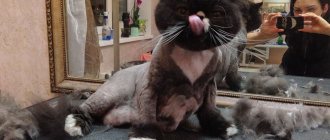The vast majority of people believe that our smaller brothers, namely cats, do not know how to express their feelings and moods. But this is not true at all. Cats' body language is very simple. The emotions of cats are very understandable and accessible to everyone.
To do this, you just have to watch carefully, and you will learn to distinguish, how to understand the cat's language. It is expressed primarily in the way the cat shakes its tail. But let's take a closer look at how and why cats shake their tail.
How to determine your pet's mood by its tail
The communicative function is one of the main ones for the tail. By waving it, the animal can demonstrate a whole range of emotions, from hatred to all-consuming love. Everything matters: the direction of movements, their amplitude and speed.
What does the position of a cat's tail indicate?
A complete dictionary of the “tailed” language could look like this:
How else can a cat “talk”?
The tail is not the only way a cat can show its attitude. Animals have quite a lot of visual aids: ears, paws, and the whole body. Quite often they convey information using sound signals.
Interesting!
Tailless cat breeds are becoming increasingly popular. Now there are several dozen of them. Some are already recognized as felinologists, others are just winning their hearts. The owners of such pets claim that the absence of a fifth limb does not interfere with their mutual understanding.
The human-cat dictionary can be supplemented with the following sections.
Communication using the body
Cat conversations can involve the whole body. With the help of movements, the animal is able to convey all important information and clarify details “left unsaid” by the tail.
| Gesture | Image | Designation |
| “I’m interested”, “I’m listening to you” | ||
| “I am completely happy, calm and content” | ||
| “There’s danger somewhere nearby, but I’m on my guard.” | ||
| “I acknowledge your superiority”, “I’m bored” | ||
| “I love you”, “I want to please you” | ||
| “You are only mine”, “Stroke me” | ||
| “I trust you completely”, “I love you” | ||
| “I need your attention”, “Stroke me” | ||
| “I feel danger, but I want to avoid a fight”; “Let’s resolve everything peacefully or I can’t vouch for myself” | ||
| "I will fight" |
Communication using glances
Eyes also play a huge role in dialogue. By studying the cat's language of views, you can not only learn to understand your pet, but also respond to him in such a way that he understands.
Rubbing your legs is not a sign of love
It doesn’t matter whether you have a cat or not: everyone knows that these animals are great lovers of rubbing themselves against the legs of not only their owners, but also just random passers-by. So, they do this not to express endless love and gratitude, but to simply leave their scent on them. Here is the answer to the question, why do we love cats?
Why do cats wag their tails?
The cat waves its tail differently, the movements reflect a certain emotion, positive or negative. The cat shakes its tail with a certain intensity, proportional to the strength of the emotions experienced.
Kittens often catch and bite their own tail, which acts as a toy and helps them acquire hunting skills.
Since a cat has an individual character and behavior, tail movements may not mean what is commonly believed. Therefore, it is recommended to determine cat emotions from your own experience, focusing on the information presented.
Positive reasons
There are many positive reasons why cats noticeably wag their tails:
- are in a playful mood and invite you to play;
- express love for the owner and household members (the vertically raised tip trembles);
- show interest, curiosity (slight twitching);
- they feel happiness, satisfaction, express complete calm (they move only the tip of their tail);
- express friendliness and trust (the caudal vertebrae are parallel to the floor);
- experience the excitement of the hunt, observe a potential victim - a mouse, a fly, a bow on a rope;
- are thoughtful (broad, relaxed movements);
- feel satisfied, want to communicate (the caudal process is lowered, relaxed);
- feel superiority and security, are confirmed in leadership (hold the organ like a “pipe”);
- thank the owner for his care and affection (the cat slowly and smoothly waves its tail).
Tail
Watching cats, many get the impression that their tail is a truly unique organ that seems to live its own life. Even if the animal’s body is motionless, the tail can “write out” the most unimaginable pretzels, by which it will be possible to guess the pet’s mood.
A tail that is in a calm state, lowered down and parallel to the ground, indicates a neutral mood. If he rises sharply, remaining in the “pipe” position, this is a clear sign of a friendly mood or joy when the owner appears. When watching potential prey or interesting events, cats show special curiosity and enthusiasm, and the tip of the tail trembles slightly at such moments. Sharp movements from side to side indicate a playful and even gambling mood of the animal. And the smoother ones are about concentrated observation of something. When a cat is irritated and dissatisfied with something, it sharply wags its tail, the tip of which is curved. A state of the highest degree of rage, aggression or external threat will help to recognize a vertically raised, fluffy tail.
How to tell if your cat is getting old
(cat sign language)
If you want to understand your animal, be sure to watch its postures. Still, you can’t rely one hundred percent on your hearing. And the cats
, like no other animals, can use facial expressions and gestures to explain what is on their mind. When we talk, some of our messages are conveyed non-verbally, that is, not through speech, but through changes in facial expression, gestures, posture and gaze. Cats also make significant use of these non-verbal signals, which perfectly convey their feelings.
Intense look
The cat may stare at you with wide eyes. And there may also be several reasons for this. Most often, in this way the animal asks to pay attention to it. It is hungry, wants affection, and feels bad. Or he wants to go to the toilet, but the tray is left behind the closed door.
With the help of a gaze, a cat can show its love. At the same time, she slowly closes her eyes. But an unfamiliar cat thus shows completely opposite emotions. She is trying to find out “who is boss” and the person, if he does not look away in time, may be attacked by an animal.
Also, the reason for a frozen gaze may be preparation for aggression. At the same time, the animal is tense, makes threatening sounds, and the tail moves from side to side.
And the most unusual reason for such a look may be the truly human pleasure we receive when, while relaxing, we look at how another person works. This is also sometimes characteristic of cats.
Other emotions
The tail will also tell you about other features of the cat’s mood. Let's see what else his movements say .
- A thoughtful wagging of the tip of the tail - something attracted the cat's attention. She listens, sniffs, looking for an object that interests her, and moves her tail to the beat of her “reflections.” At such moments it becomes like a question mark.
- Calm wiggles while playing with the owner demonstrate her good disposition and pleasure from having fun together. However, during gameplay the cat may begin to cross the boundaries of permitted behavior. This will be noticeable by the accelerating movements of the tail, which may be followed by painful bites and scratches on the person.
- Cats wag their tails vertically when they are either sexually aroused or want to play.
- When a cat, instead of waving its tail, taps it on the floor with small nervous movements, this means that it is not just nervous, but is experiencing stress. Also, tapping often indicates that your pet is in pain. Having noticed that the cat began to wag its tail in this way, the owner needs to be alert and provide assistance to the animal.
Some owners notice that the cat constantly wags its tail when dozing. Smooth, gradually subsiding movements indicate that the animal is comfortable, it feels safe and is gradually going to sleep. Having fallen soundly asleep, cats sometimes also begin to twitch their tail. Scientists believe that they dream and react to them in a similar way. Having noticed such body movements in a sleeping pet, the owner need not worry - his pet is simply “chasing” another mouse in his sleep.
© shutterstock
Acuity of touch
A cat's sense of smell is approximately 14 times stronger than a human's. At the same time, they hear perfectly, even picking up ultrasound. This ability is due to the fact that they hunt small rodents that communicate with each other at high frequencies.
Why does a cat have a tail?
There is a belief that a cat should not be pulled by the tail, otherwise it will start shitting in inappropriate places. It is unclear what this statement is based on, but the tail of cats and cats really needs to be handled carefully. Damage to this organ requires immediate veterinary intervention. Sometimes it even has to be amputated.
A cat's tail is an extension of its spine. It consists of approximately 2-3 dozen vertebrae, thanks to the mobility of which animals wave their tail. There are also many nerve endings there. That's why cats almost always show anxiety when their owners touch their tail. When treated with such disrespect, they begin to wag at them anxiously.
Initially, nature gave cats this organ not for communication with humans. The tail helps the animal:
- ensure body balance when jumping;
- coordinate movements when walking on narrow surfaces;
- maneuver when falling;
- navigate in complete darkness;
- when in contact with other animals, give them various signals (for example, warn that the cat is ready to attack).
However, over the thousand-year history of cat domestication, she has learned to use tail wagging to “talk” with humans. An experienced and attentive owner recognizes by its movement how his pet is feeling, whether the animal needs to be supported, or, on the contrary, left alone. Cat body language is very informative, and knowing it will greatly benefit the owner.
The tail is pipe-shaped and slightly rounded at the tip.
The arched back and the upturned, tousled tail are a reaction to danger or threat. This means that the cat is ready to attack at any moment, and it is better for others not to try to come into contact with the animal.
A vertically positioned vibrating tail indicates pleasure and a state of bliss in which the pet is, for example, when meeting its owners after a long day of work. This gesture can often be seen in kittens who are exploring the world around them or happily running towards a bowl of milk. Young animals often show their pleasure this way during active play with some kind of bait.
All these gestures are quite easy to remember; all that remains is to react correctly to the pet’s behavior. For an observant owner, recognizing a cat's behavior at home will be easy. This way you can understand what exactly pleases or annoys your pet and increase the comfort of living with him.
Cat behavior is worth studying if only because they can be trained like dogs. You just need to understand cat language. Cats are not stupid, but they are a little willful, but if you understand them, you can make a great friend.
True, cats are not as attached to people as dogs, but they can become more attached to a person than to a house. A cat or cat may miss its owner during separation, not allowing strangers near it, even if the cat is on its own territory.
From such separations, the cat may even get sick, for example, cystitis. While cats themselves are able to relieve stress in humans and normalize blood pressure, cats are so sensitive to any negative energy.
It’s not for nothing that cats were considered sacred animals in ancient Egypt. And even now, both men and women love cats for their beauty, for their grace, for their playful character, and for many other reasons. But, unfortunately, we don’t always understand cats.
Cat sign language
As the cat Matroskin said from the cartoon “Three from Prostokvashino”: “Whiskers, paws and tail - these are my documents.” And this statement is not far from the truth. These cat body parts can tell their owner a lot. You can tell a cat's mood by its whiskers (whiskers). When they are lowered, it means that the cat is upset about something.
A cat takes a “milk step” with its paws when it is happy. This is how kittens stimulate the release of milk from the mother cat’s nipples. This action reminds her of moments of bliss, and the cat may “purr” with pleasure.
If a cat has a “pipe” tail, this means that it greets its owner.
What does it mean when a cat wags its tail?
Everyone knows that the tail
- This is not only a decoration for a cat. It helps to successfully land on the ground or floor when jumping from a height, to balance fearlessly on fences and tree branches, coordinating the balance of the animal. And the tail of mustachioed pets is a real mood indicator. Unable to express their emotions through words, our smaller brothers use body language. And, perhaps, the movements of a cat’s tail can demonstrate to the owner what the animal is experiencing, more eloquently than any meow.
Functions of the tail
A cat's tail is very important. It plays a big role in the life of the animal, in particular, it is responsible for:
- balancing;
- spatial orientation;
- communication;
- health (one of its indicators);
- entertainment.
Tail instead of rudder
The tail has another interesting feature - it can be used to steer. The cat uses this function to freely control its own body. Naturally, this happens unconsciously. Nature gave this opportunity to the cat. The tail becomes an assistant in any maneuvers during the hunt to overcome obstacles. The fluffy steering wheel is designed to maintain balance when cornering.
When a cat falls or jumps from a height, the tail takes on the function of balancing, helping to take the desired position so that it can land in a position that is safe for the animal. This is possible because the tail can rotate and twitch intensely during flight.
The tail helps the cat land in the right place and in a safe position
There are cats that really like to swim. Here we are not talking about certain breeds, but about individual “personalities”. In any case, all felines can swim, but only a few love it. So, during swimming, the tail acts as a rudder.
In addition, the tail helps balance when the animal walks on a narrow surface, such as a parapet.
Cats use their tails to balance on narrow surfaces.
In addition to special breed cats, there are animals that have lost their tail due to injury or injury. For some time it is very difficult for the animal to cope with obstacles, but adaptation occurs quite quickly. The cat will be able to adapt to tailless life.
Tailless breeds are also not deprived of nature. Instead of a long tail, they have well-developed hind legs, which gives maximum stability to the animal’s body.
Microclimate
In addition to all the advantages listed above, the tail has one more thing: it helps the cat keep warm. Everyone has seen how the cat assumes a ball pose and covers its nose with its tail. This keeps you from freezing. Considering the heat-loving nature of these animals, the microclimate created by the tail is simply irreplaceable.
Tail and expression of emotions
In addition to physical functions, a cat can communicate through its tail. A long study of cats has revealed some basic emotional expressions:
- the tail is tousled - the cat is excited about something. It could be fear or, conversely, something pleasant, for example, a game;
- the tail hits the floor or twitches - the cat is nervous, he doesn’t like something. At this time, it is better not to disturb the animal;
- the tail is raised at an angle of 45 degrees - the animal expresses wariness and suspicion;
- tail up - joy;
- the tail in its natural state expresses calmness. The same thing is meant by a tail wrapped around the body of an animal;
- the tail is clamped between the paws - an expression of fear. The cat will not offer resistance and intends to surrender;
- the tip of the tail trembles - an expression of interest;
- the tail hits the cat on the sides - the animal is preparing for a fight.
The cat uses its tail to express its emotions
Why you shouldn't pull your pet's tail
The cat should not be pulled by the thin tail vertebrae. According to popular belief, the pet will begin to defecate in the wrong corners. In reality, these actions are cruel, physically unpleasant for the animal, cause discomfort, and often cause injury and illness.
A bully, grabbing a cat wagging its tail, can injure the vertebrae, requiring surgical assistance or amputation.
Often hooligan actions lead to paralysis of the hind limbs and urinary incontinence in the pet.
Cats are vengeful, tugging and squeezing - which means humiliation of dignity - does not forgive, they begin to take revenge.
Feeling jealous
There are legends about cat jealousy. They very clearly show their indignation when a newborn appears in the family or a new pet (kitten or puppy). The cat considers himself a royal person and the master of your apartment, and believes that any major changes must be agreed upon with him. Small nasty things from the still cute and calm cat cannot be avoided. Do not rush to give it to other hands, let it get used to new circumstances. After all, the cat experienced enormous stress; a rival appeared on his territory, encroaching on his unlimited power. The cat is afraid of losing the love of its owner, be patient and understanding. And with new pets, it is better to demarcate the territory, at least until they become friends.
Cats are happy and sad. They are able to experience not only emotions, but also a feeling of love. Each of them has their own favorite toys, food and favorite places in the house. Take care of your pets, and they will thank their beloved owner with their warmth and tender affection.
How cats show their mood
A cat's tail consists of many vertebrae and performs a large number of functions. The main role is balancing during movement and hunting. But a cat's tail is also an expression of her behavior and character. This means that if the owner is attentive and loving, then it will be easy for him to determine the cat’s mood by the tail. It is when and how a cat shakes its tail that you can understand what mood it is in.
A cat's tail twitches in different ways - both vertically and horizontally. To figure out how to understand a cat by its tail, you need to take into account many factors. These may include:
- people unfamiliar and incomprehensible to them. For older cats, this can be a stressful environment. And if this is a cat with kittens, then the trembling tail will immediately let you understand displeasure and fear for its offspring;
- general situation in the breeder’s family. If you constantly scream and at the same time can periodically hit the kitten, you should be prepared for the fact that the cat arches its back and its tail is fluffed or tucked. But when you love and cherish your pet, then his tail will almost always be a pipe, and the threat of an arched back and hissing sounds will bypass you;
- If an animal beats its tail, meows, shakes, its pupils are dilated and it tucks or arches its tail, then the pet is letting you know that it is experiencing fear. In such a situation, it is better to remove the object that provoked panic;
- An unfamiliar environment or moving can also cause displeasure in the pet, which will be expressed in the fact that the cat jerks its fifth limb. Let her know that you are looking out for her and want the best for her.
INTERESTING TO KNOW: Why does a cat drool?
Cats can perfectly understand what you are communicating with them about. As the kitten grows up, it learns to understand its owner, and you learn how to determine its mood and how to understand your pet’s language.
How cats communicate using their tails
It is not always possible to understand from the face how to determine the mood of the animal and figure out what the cat wants. And it is the cat’s tail that will tell you about all the thoughts and emotions of the pet. Let's look at specific examples of why and how a cat twitches its tail:
- The four-legged pet smoothly swings its tail horizontally in different directions. Cat experts indicate this gesture as the fact that she cannot immediately make a choice between her desires. When the decision is made, the animal will calm down and stop twitching;
- if a cat lifts its tail and puts it vertically, it tells you that the pet’s thoughts are very interested in something;
- a slight twitch indicates strong affection and love for you;
- if the cat’s fifth limb is down, it means that she is bored;
- the tail is up, but the back is arched and the ears are pressed back - the cat cannot decide whether to attack or defend. He is very scared;
- the tail is in a curved arc position and the cat arches its back - it senses danger and is ready to defend itself. In this state, do not hit her and try to calm her down;
- a tail raised up (vertically) indicates that the animal is in a great mood and is ready for games and communication;
- a loosely drooping tail tells that the pet is in a calm mood, but is not inclined to communicate;
- a measured and rather strong horizontal waving of the tail indicates dissatisfaction and irritation;
- a wary animal's tail is lowered and ruffled;
- only the tip of the tail moves slightly - at the moment the pet is in an excellent mood and is happy with everything that is happening around him;
- the cat’s tail trembles and moves horizontally in different directions faster and faster - the hunt is in full swing and an attack on the prey will occur in the coming seconds;
- a vertically extended, quivering tail denotes a playful mood. It’s worth considering here that if the movements become faster and sharper, the cat beats its tail and may start meowing - the animal is getting too excited and it’s time to stop it. This is especially true when playing with small children - the danger of scratches and bites from a cat is too great;
- a tail wrapped in a ring around the body speaks of an excellent mood and trust in the surrounding world;
- the tail is raised halfway - the pet is confused and cannot determine its attitude towards a person or animal - to understand whether it is a friend or an enemy;
- fluffy tail and fur along the spine - the cat is furious;
- a vertically raised tail may mean that the cat is marking territory;
- sharp waving or tapping indicates stress and possibly pain;
- biting the tail signals the presence of parasites;
- in cold weather, cats wrap their tail in a ring around themselves, thereby reducing heat transfer;
- a vertically raised tail with a relaxed tip indicates joyful excitement;
- sits or lies with the fifth limb calmly extended - the cat is resting;
- in a sitting position, with paws tucked and tail wrapped - the animal is relaxed, but waiting for some action;
- a slight twitching of the whole body along with the tail means happiness and calmness of the pet. You can observe this when stroking it, scratching its ears or back. Will also be expressed in loud purring and squinting of the eyes;
- a leisurely and rhythmic twitching of the tail vertically indicates interest in something. The cat is relaxed, does not feel danger and is concentrated on the object of its attention. It is also expressed in the fact that the animal walks around the object of its interest and sniffs it;
- the desire to attack can be expressed in walking the fifth limb from side to side. If this occurs when playing with inanimate objects, then there is no need to worry. As soon as the cat gets tired of this activity, it will move away from it and forget about it quite quickly. At least until the next surge in gaming activity.
INTERESTING TO KNOW: Proper care of a Persian cat
Cats move their fifth limb almost constantly. There are many explanations for this fact. When communicating, you just need to pay attention to your pet’s mood. When there is mutual understanding between the owner and the pet, when they can understand and feel each other, then there will be practically no problems in communication.
Just listen to what your cat is telling you. Indeed, contrary to popular belief, tail twitching can also mean great love and devotion towards you.
How to tell how a cat is feeling by its tail
The movements of a cat's tail can serve as an indicator of health. Having fallen ill, the animal will begin to make movements that were previously unusual for it. This is a sign that you need to take a closer look at your pet’s behavior and, if you notice other warning signs, contact your veterinarian.
You can tell how your cat is feeling by the movement of his tail.
Attention! Sharp twitching of the tail can be a signal that the animal has reached puberty and is experiencing excitement. If a pet shakes its tail when near a wall or piece of furniture, it means it is marking its territory.
The following table will help you understand what is happening in your pet’s body.
| Disease | Tail movement | Other signs | Image |
| Rabies | Sharp convulsive twitching of the tail and back | Refusal of water while maintaining appetite, excessive salivation, aggression or attempts to hide | |
| Neurosis | Chaotic twitching of the tail and whole body | Excessive licking, leading to deterioration in coat quality | |
| Parasite infestation | Sudden twitching of the tail and back of the back | Frequent scratching, sudden movements, attempts to catch fleas with teeth | |
| Oncological diseases | Frequent, chaotic movements of the tail | Lethargy, lack of appetite | |
| Tail injuries | Tail tucked | Lethargy, irritability, lack of appetite |
For all its simplicity, a cat's tail is capable of performing a wide variety of tasks. With its help, a pet can not only talk about its feelings, but also hint at its well-being. Therefore, it is so important for every responsible owner to know this special language.
How to tell a cat's mood by its face
According to felinologists, experts in the field of keeping cats, the expression of an animal’s face can tell a lot about emotions.
Depending on the mood of the pet, the gaze and position of the ears may be different.
Giraffes have no problems with blood pressure: the long-necked gene will help people with hypertension
Products are fermented: culinary tricks of the peoples of the world for a beautiful figure
Israel plans to open soon: the best places to visit in this country
- Calm state - the ears are in a vertical position, the gaze is relaxed and calm.
- Wants to play - eyes wide open, ears raised up.
- Angry and angry - ears are turned back, pupils are narrowed.
- Satisfied and, in principle, enjoying life - the eyes are slightly closed, the muscles on the face are relaxed.
- Aggressive - eyes wide open, pupils dilated, ears pressed to the head.
Now, when communicating with your pet, you will always know what mood he is in and when he should not be disturbed.
